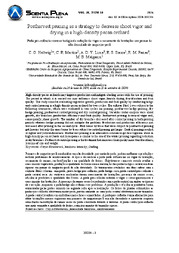Postharvest pruning as a strategy to decrease shoot vigor and drying in a high-density pecan orchard.
Postharvest pruning as a strategy to decrease shoot vigor and drying in a high-density pecan orchard.
Author(s): HELLWIG, C. G.; MARTINS, C. R.; LIMA, A. D. V.; SOUZA, R. de S.; FARIAS, R. de M.; MALGARIM, M. B.
Summary: ABSTRACT: High-density pecan orchardsmayimprove production and mitigate shading issueswith the use of pruning. The period in which it is carried out may influence shootvigor, branch drying, fructification and fruit quality. This study aimed at evaluating vegetative growth, production and fruit quality by conducting hedge and central pruning in a high-density pecan orchardfor two cycles. The cultivar Pitol 1 was subject to the following treatments, which were evaluated in two cycles: no pruning, postharvest hedge pruning, dry hedge pruning, postharvest central pruning and dry central pruning. Variables under analysis were shootgrowth, dry branches, production efficiency and fruit quality. Postharvest pruning decreased vigor and, consequently, shootgrowth. The number of dry branches decreased after central pruning in both pruning periods whereas hedge pruning did not mitigate the problem. Production and production efficiency just increased after pruning in the second cycle. Fruit borne by treesthat were subject to postharvest pruning got heavier but only the ones borne by treessubject to central pruning got larger. Central pruning resulted in lighter and yellowish kernels. Postharvest pruning is an alternative solution to get less vigorous shootin high-density pecan orchards and its response is similar to the one of the winter pruning regarding reduction in dry branches. Postharvest central pruning is the treatment that increases fruit quality more than the others, in terms of size and weight. // RESUMO: Pomares de nogueira-pecã conduzidos em alta densidade,por meio da poda,podemmelhorar a produção e reduzirproblemas de sombreamento. A época de realizar a poda pode influenciar no vigor da brotação, secamento de ramos, na frutificaçãoe na qualidade de frutos. Objetivou-se com este estudo avaliar o crescimento vegetativo, produção e qualidade de frutos com a realização das podas hedge e central em duas épocas em pomar de nogueira-pecã de alta densidade.Os tratamentos avaliados em duas safrascom a cultivar Pitol 1foram: sem poda, poda hedge pós-colheita,poda hedgeseca, poda central pós-colheita e poda central seca. As variáveis analisadas foram crescimento de brotações, presença de ramos secos, eficiência produtiva equalidade dos frutos.A poda pós-colheita reduziuo vigor e consequentemente o crescimento das brotações. A presençade ramos secos foireduzida com a poda central em ambas as épocas de execução, enquanto a poda hedge não reduziu esse problema. A produção e eficiência produtiva foram aumentadas pelas podas somente na segunda safra após a realização.Os frutos de plantas submetidos as podas pós-colheita obtiveram maior peso, porém somente as com poda central obtiveram maior tamanho.A poda central resultou em amêndoas mais claras e amareladas.A poda pós-colheita é uma alternativa para obter brotações menos vigorosas em pomares de nogueira-pecã em alta densidadeeapresenta resposta semelhante na redução de ramos secos dapodaexecutada durante o inverno.A poda central pós-colheita que mais aumentaa qualidade de frutos, com incremento de tamanho e peso.
Publication year: 2024
Types of publication: Journal article
Observation
Some of Embrapa's publications are published as ePub files. To read them, use or download one of the following free software options to your computer or mobile device. Android: Google Play Books; IOS: iBooks; Windows and Linux: Calibre.
Access other publications
Access the Agricultural Research Database (BDPA) to consult Embrapa's full library collection and records.
Visit Embrapa Bookstore to purchase books and other publications sold by Embrapa.

